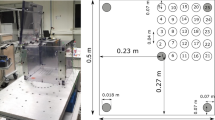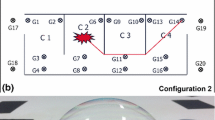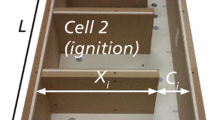Abstract
It is well established that detonation in a confined environment can lead to the formation of a Mach stem along the walls or after diffraction on an obstacle. As the formation of this kind of reflection can produce higher levels of overpressure, it is important to study and understand its formation and propagation for safety purposes in the event of an accidental or intentional detonation. This paper reports an experimental approach to the propagation of a Mach stem formed by the diffraction of a shock wave around an obstacle and compares the height of the triple point with an empirical model from Kinney and Graham. In predictive models, the Mach stem is formed by a charge detonating above the ground, which is why its evolution is different from a Mach stem formed after diffraction. The shock waves were generated by the detonation of a stoichiometric hemispherical charge of propane-oxygen. The visualization was coupled with 30 pressure sensors to record pressure history data in order to determine the influence of the Mach stem on wall overpressure inside a small-scale model, representing two rooms in a building separated by an open door.















Similar content being viewed by others
References
Ben-Dor, G.: Shock Wave Reflection Phenomena. Springer, Berlin (2007). https://doi.org/10.1007/978-3-540-71382-1
Kinney, G.F., Graham, K.J.: Explosive Shocks in Air. Springer, Berlin (1985). https://doi.org/10.1007/978-3-642-86682-1
Kisters, T., Kuder, J.: Experimental characterization of a near-field HOB-detonation. 22th International Symposium on Military Aspects of Blast and Shock, Bourges, France, 04–09 November (2012)
Leete, K.M., Gee, K.L., Neilsen, T.B., Truscott, T.T.: Mach stem formation in outdoor measurements of acoustic shocks. J. Acoust. Soc. Am. 138, 522–527 (2015). https://doi.org/10.1121/1.4937745
Needham, C.E.: Blast Waves: Shock Wave and High Pressure Phenomena. Springer, Berlin (2018). https://doi.org/10.1007/978-3-319-65382-2
Boutillier, J., Ehrhardt, L., De Mezzo, S., Deck, C., Magnan, P., Naz, P., Willinger, R.: Evaluation of the existing triple point path models with new experimental data: proposal of an original empirical formulation. Shock Waves 28, 243–252 (2018). https://doi.org/10.1007/s00193-017-0743-7
Xiao, W., Andrae, M., Gebbeken, N.: Development of a new empirical formula for prediction of triple point path. Shock Waves 30, 677–686 (2020). https://doi.org/10.1007/s00193-020-00968-7
U.S. Department of the Army, Unified Facilities Criteria (UFC), Structures to Resist the Effects of Accidental Explosions. UFC-3-340-02. Washington (2008)
Whitham, G.B.: A new approach to problems of shock dynamics, part 1: two dimensional problems. J. Fluid Mech. 2, 145–171 (1957). https://doi.org/10.1017/S002211205700004X
Parks, E.K.: Supersonic flow in a shock tube of divergent cross-section. UTIA Report No. 18, University of Toronto, Canada (1952)
Skews, B.W.: The shape of a diffracting shock wave. J. Fluid Mech. 11, 297–304 (1967). https://doi.org/10.1017/S0022112067000825
Koroteeva, E.Y., Znamenskaya, I.A., Glazyrin, F.N., Sysoev, N.N.: Numerical and experimental study of shock waves emanating from an open-ended rectangular tube. Shock Waves 26, 269–277 (2016). https://doi.org/10.1007/s00193-016-0650-3
Hargather, M.J., Settles, G.S.: Optical measurement and scaling of blasts from gram-range explosive charges. Shock Waves 17, 215–223 (2007). https://doi.org/10.1007/s00193-007-0108-8
Igra, O., Wang, L., Falcovitz, J., Heilig, W.: Shock wave propagation in a branched duct. Shock Waves 8, 375–381 (1998). https://doi.org/10.1007/s001930050130
Gault, K., Sochet, I., Hakenholz, L., Collignon, A.: Influence of the explosion center on shock wave propagation in a confined room. Shock Waves 30, 473–481 (2020). https://doi.org/10.1007/s00193-020-00946-z
Rigby, S.E., Akintaro, O.I., Fuller, B.J., Tyas, A., Curry, R.J., Langdon, G.S., Pope, D.J.: Predicting the response of plates subjected to near-field explosions using an energy equivalent impulse. Int. J. Impact Eng. 128, 24–36 (2019). https://doi.org/10.1016/j.ijimpeng.2019.01.014
Edri, I., Savir, Z., Feldgun, V.R., Karinski, Y.S., Yankelevsky, D.Z.: On blast pressure analysis due to a partially confined explosion, I: experimental studies. Int. J. Protect. Struct. 2, 1–20 (2011). https://doi.org/10.1260/2041-4196.2.1.1
Bazhenova, T., Gvozdeva, L., Zhilin, Yu.: Change in the shape of the diffracting shock wave at a convex corner. Acta Astronautica 6, 401–412 (1978). https://doi.org/10.1016/0094-5765(79)90107-3
Bazhenova, T., Gvozdeva, L., Nettleton, M.: Unsteady interactions of shock wave. Prog. Aerosp. Sci. 21, 249–331 (1984). https://doi.org/10.1016/0376-0421(84)90007-1
Tracker (Video Analysis and Modeling Tool). https://physlets.org/tracker/
Eveillard, S.: Propagation d’une onde de choc en présence d’une Barrière de Protection. University of Orléans, France, Thesis (2013)
Sauvan, P.E., Sochet, I., Trélat, S.: Analysis of reflected blast wave pressure profiles in a confined room. Shock Waves 22, 253–264 (2012). https://doi.org/10.1007/s00193-012-0363-1
Acknowledgements
This work was funded by DGA Techniques Navales under contract No. 15-86-0027.
Author information
Authors and Affiliations
Corresponding author
Additional information
Communicated by M. Hargather.
Publisher's Note
Springer Nature remains neutral with regard to jurisdictional claims in published maps and institutional affiliations.
Rights and permissions
About this article
Cite this article
Ruscade, G., Sochet, I. & Djafer, K. Mach stem evolution in a confined multi-room. Shock Waves 32, 395–404 (2022). https://doi.org/10.1007/s00193-022-01083-5
Received:
Revised:
Accepted:
Published:
Issue Date:
DOI: https://doi.org/10.1007/s00193-022-01083-5




